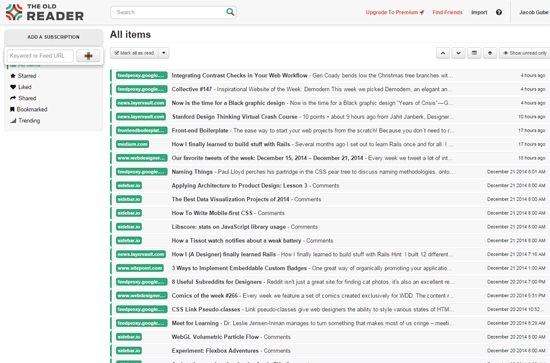

There are certain basic features of the web that can be leveraged to make your feeds a little better.įor example, be sure to compress your feeds, as it greatly reduces the overall file size and the time to download it. Here’s a good look into how various sites name their feeds, but I’ve named mine feed.json, and for JSON feed, Atom, and RSS respectively.

Oh, you want to subscribe to the CSS-Tricks RSS feed? Please do! Your RSS feed is just as much a thing to follow as any social network.Īs for what to name the feed itself, it doesn’t matter as long as it’s discoverable. Some feed readers can pick up on these links, too, even though they are outside of the. This is the link to the site’s RSS and it’s available in the footer across the entire site. What else can you do to make your feed easy to find? Advertise it! Place direct links to the feeds somewhere prominent on your site that people can use to copy and paste into their feed reader. There’s also the option to add a title which never hurts. The important thing is that one includes rel="alternate" and the feed’s MIME type. Here’s an example showing all three formats linked up in the document head: Īnd, yes, it’s OK to use all three! You can specify as many links as you want, though some feed readers might only recognize the first one. This way, feed readers are able to crawl and recognize when a site offers a content feed. And one way to make a feed discoverable is to link it up in the of your site. It doesn’t help to have a feed if no one knows about it. Like most things on the web, there are things we can do to optimize our work to get the most out of it. Let’s look at some best practices for making feeds. Unless your application has a specific use case that requires a specific format (like podcasts), it doesn’t hurt to provide multiple formats, but RSS and Atom have the most support. You might think that the size of the file could be a possible difference, but compression reduces them all to just a few kilobytes apiece. Other than these things, there are only minor differences between them. RSS uses the tag (or the content extension) which either contains XML-escaped HTML or the HTML unescaped in a tag. Atom uses the content tag with type=html containing XML escaped HTML. JSON uses the content_html key containing JSON escaped HTML. All allow HTML markup, though they handle it differently.While all of the formats require a unique identifier for each entry/item, Atom takes it a step further as it requires a unique identifier for every feed.If you have a podcast, however, RSS is a must. JSON feed is a newer feed format meaning that support for it might not be as broad as Atom or RSS.One example of this is on podcast feeds which declare the iTunes podcast namespace, allowing for the use of tags. With Atom and RSS, you do this by declaring the namespace on the root element. In a JSON feed, this is done by adding an object with a key that starts with an underscore anywhere in a feed’s object. All of these formats can be extended in some way.Atom and RSS are based on XML while a JSON feed is based on, well, JSON.While Atom, RSS and, JSON feeds accomplish the same thing, there are a few differences between them: Google Trends for Atom, JSON, RSS and web feeds. I’ve used RSS to signify these formats since it’s a far more popular search term but I’ll refer to these technologies as web feeds in this article unless I’m referring to a specific format. JSONīelieve it or not, RSS is just one format among other types of syndicated web feeds.
Javascript rss reader how to#
Let’s talk about the different kinds of feeds, how to implement them, and what strategies you can use to get the most out of your feed content. That’s exactly what I’m going to walk you through in this article. Whatever the case, RSS is a web technology like any other, and there are best practices for how to create and curate a feed. Or maybe you’re like Chris here at CSS-Tricks and still love RSS. Maybe you used to be an RSS fan and need to get re-acquainted with it. You may have heard whispers that “RSS in dead” around the web, but the truth is that they are still widely used as virtually every podcast uses one.


 0 kommentar(er)
0 kommentar(er)
